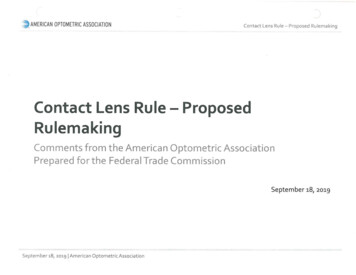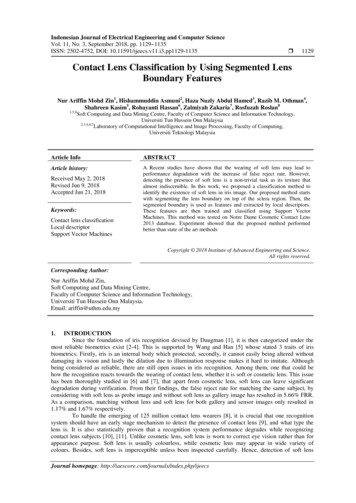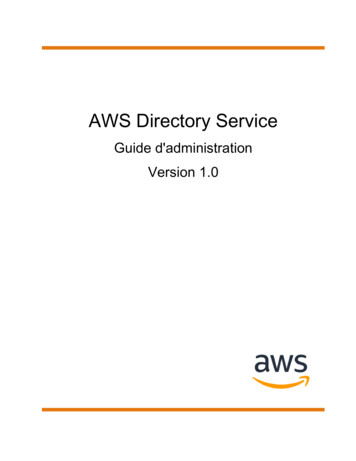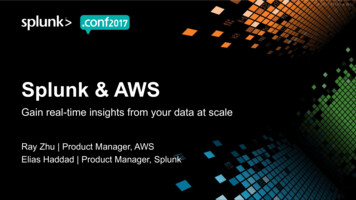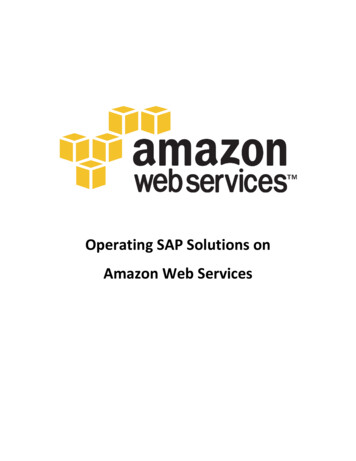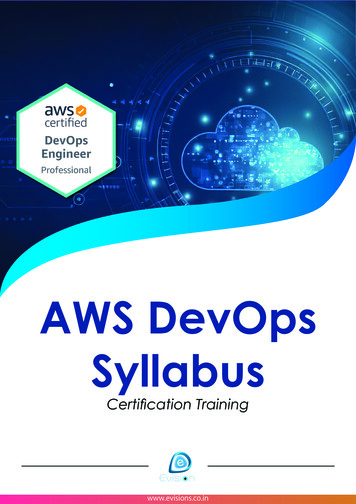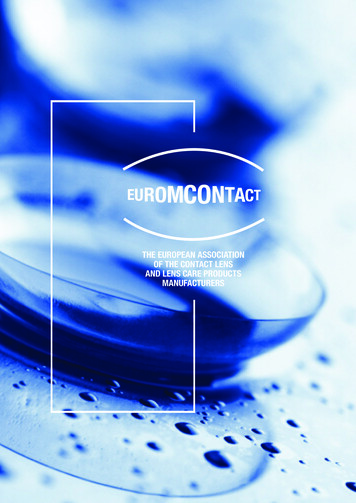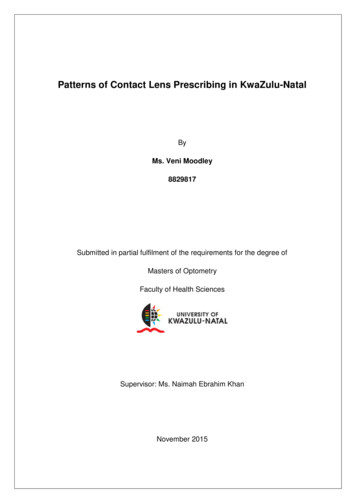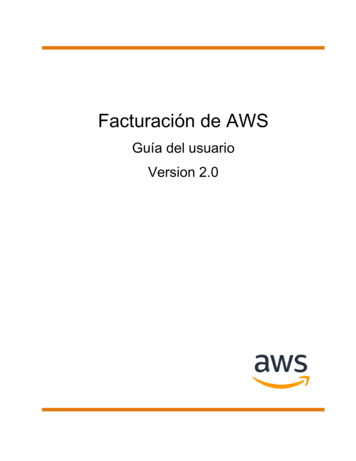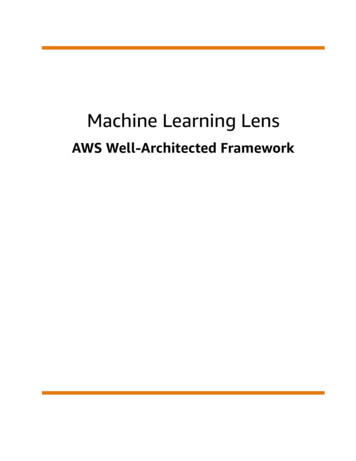
Transcription
Machine Learning LensAWS Well-Architected Framework
Machine Learning Lens AWS Well-Architected FrameworkMachine Learning Lens: AWS Well-Architected FrameworkCopyright Amazon Web Services, Inc. and/or its affiliates. All rights reserved.Amazon's trademarks and trade dress may not be used in connection with any product or service that is notAmazon's, in any manner that is likely to cause confusion among customers, or in any manner that disparages ordiscredits Amazon. All other trademarks not owned by Amazon are the property of their respective owners, who mayor may not be affiliated with, connected to, or sponsored by Amazon.
Machine Learning Lens AWS Well-Architected FrameworkTable of ContentsIntroduction . iIntroduction . 1Well-Architected Framework pillars . 2Well-Architected machine learning lifecycle . 3Well-Architected machine learning design principles . 5Well-Architected machine learning . 6Business goal identification lifecycle phase . 6Operational Excellence pillar best practices . 7Security pillar best practices . 8Reliability pillar best practices . 9Performance Efficiency pillar best practices . 10Cost Optimization pillar best practices . 11ML problem framing lifecycle phase . 12Operational Excellence best practices . 13Security pillar best practices . 18Reliability pillar best practices . 19Performance Efficiency pillar best practices . 21Cost Optimization pillar best practices . 24Lifecycle architecture diagram . 27Data processing lifecycle phase . 30Data collection . 31Data preparation . 32Operational Excellence pillar – Best Practices . 34Security pillar – Best Practices . 36Reliability pillar – Best Practices . 40Performance Efficiency pillar – Best Practices . 42Cost Optimization pillar – Best Practices . 43Model development lifecycle phase . 46Model training, tuning . 47Model evaluation . 49Operational Excellence pillar – Best Practices . 49Security pillar – Best Practices . 51Reliability pillar – Best Practices . 54Performance Efficiency pillar – Best Practices . 57Cost Optimization pillar – Best Practices . 61Deployment lifecycle phase . 68Operational Excellence pillar – Best Practices . 70Security pillar – Best Practices . 72Reliability pillar – Best Practices . 73Performance Efficiency pillar – Best Practices . 75Cost Optimization pillar – Best Practices . 76Monitoring lifecycle phase . 77Operational Excellence pillar – Best Practices . 78Security pillar – Best Practices . 80Reliability pillar – Best Practices . 82Performance Efficiency pillar – Best Practices . 84Cost Optimization pillar – Best Practices . 89Conclusion . 91References . 92Document history and contributors . 93Contributors . 93Best practices arranged by pillar . 94Operational excellence pillar . 94Security pillar . 94iii
Machine Learning Lens AWS Well-Architected FrameworkReliability pillar .Performance efficiency pillar .Cost optimization pillar .Notices .AWS glossary .iv9495959798
Machine Learning Lens AWS Well-Architected FrameworkIntroductionMachine Learning LensPublication date: October 12, 2021 (Document history and contributors (p. 93))Machine learning (ML) algorithms discover and learn patterns in data, and construct mathematicalmodels to enable predictions on future data. These solutions can revolutionize lives through betterdiagnosis of diseases, environment protection, products and services transformation, and more.This whitepaper provides you with a set of established cloud and technology agnostic best practices. Youcan apply this guidance and architectural principles when designing your ML workloads, or after yourworkloads have entered production as part of continuous improvement. The paper includes guidanceand resources to help you implement these best practices on AWS.IntroductionThe AWS Well-Architected Framework helps you understand the benefits and risks of decisions you makewhile building workloads on AWS. By using the Framework, you will learn operational and architecturalbest practices for designing and operating workloads in the cloud. It provides a way to consistentlymeasure your operations and architectures against best practices and identify areas for improvement.Your ML models depend on the quality of input data to generate accurate results. As data changeswith time, monitoring is required to continuously detect, correct, and mitigate issues with accuracy andperformance. This may even require you to retrain your model with the latest refined data.Application workloads rely on step-by-step instructions to solve a problem. ML workloads enablealgorithms to learn from data through an iterative and continuous cycle. The ML lens complementsand builds upon the Well-Architected Framework to address this difference between these two types ofworkloads.This paper is intended for those in a technology role, such as chief technology officers (CTOs), architects,developers, data scientists, and ML engineers. After reading this paper, you will understand the bestpractices and strategies to use when you design and operate ML workloads on AWS.1
Machine Learning Lens AWS Well-Architected FrameworkWell-Architected Framework pillarsThe AWS Well-Architected Framework provides architectural best practices for designing and operatingworkloads in the cloud. The Framework consists of five pillars. Operational Excellence — Includes the ability to run, monitor, and gain insights into workloads. Itenables delivering business value and improves supporting processes and procedures. Best practicefocus areas include: organization, prepare, operate, and evolve. Security — Includes the ability to protect information, systems, and assets. It enables deliveringbusiness value through risk assessments and mitigation strategies. Best practice focus areas include:identify and access management, detection, infrastructure protection, data protection, andincident response. Reliability — Includes the ability of a workload to recover from infrastructure or service disruptions.Ensures a workload performs its intended function correctly and consistently when it’s expected to.It enables dynamically acquiring computing resources to meet demand, and mitigating disruptionssuch as misconfigurations and transient network issues. Best practice focus areas include: foundations,workload architecture, change management, and failure management. Performance Efficiency — Focuses on the efficient use of computing resources to meet requirements.It enables maintaining efficiency as demand changes and technologies evolve. Best practice focusareas include: architecture selection, review, monitoring, and trade-offs. Cost Optimization — Includes the continual process of refinement and improvement of a system overits entire lifecycle. It enables building and operating cost-aware systems that minimize costs, maximizereturn on investment, and achieve business outcomes. Best practice focus areas include: practicecloud financial management, expenditure and usage awareness, cost-effective resources, managedemand and supplying resources, and optimize over time.While this paper focuses on the details specific to ML workloads, you can refer to the AWS WellArchitected Framework whitepaper for more information on the Framework and its pillars.2
Machine Learning Lens AWS Well-Architected FrameworkWell-Architected machine learninglifecycleThe ML lifecycle is the cyclic iterative process with instructions, and best practices to use across definedphases while developing an ML workload. The ML lifecycle adds clarity and structure for making amachine learning project successful. The end-to-end machine learning lifecycle process illustrated inFigure 1 includes the following phases: Business goal identification ML problem framing Data processing (data collection, data preprocessing, feature engineering) Model development (training, tuning, evaluation) Model deployment (inference, prediction) Model monitoringThe phases of the ML lifecycle are not necessarily sequential in nature and can have feedback loops, afew of which are illustrated in Figure 1, to interrupt the cycle across the lifecycle phases.Figure 1: ML lifecycleThe following is a quick introduction to each phase, which will be expanded upon later in this paper.Business goalAn organization considering ML should have a clear idea of the problem, and the business value to begained by solving that problem. You must be able to measure business value against specific businessobjectives and success criteria.3
Machine Learning Lens AWS Well-Architected FrameworkML problem framingIn this phase, the business problem is framed as a machine learning problem: what is observed andwhat should be predicted (known as a label or target variable). Determining what to predict and howperformance and error metrics must be optimized is a key step in this phase.Data processingTraining an accurate ML model requires data processing to convert data into a usable format. Dataprocessing steps include collecting data, preparing data, and feature engineering that is the process ofcreating, transforming, extracting, and selecting variables from data.Model developmentModel development consists of model building, training, tuning, and evaluation. Model buildingincludes creating a CI/CD pipeline that automates the build, train and release to staging and productionenvironments.DeploymentAfter a model is trained, tuned, evaluated and validated, you can deploy the model into production. Youcan then make predictions and inferences against the model.MonitoringModel monitoring system ensures your model is maintaining a desired level of performance throughearly detection and mitigation.The Well-Architected ML lifecycle, shown in Figure 2, takes the machine learning lifecycle just described,and applies the Well-Architected Framework pillars to each of the lifecycle phases.Figure 2: Well-Architected ML lifecycle4
Machine Learning Lens AWS Well-Architected FrameworkWell-Architected machine learningdesign principlesWell-Architected ML design principles are a set of considerations used as the basis for a well-architectedML workload.Following the Well-Architected Framework guidelines, use these general design principles to facilitategood design in the cloud for ML workloads: Assign ownership — Apply the right skills and the right number of resources along with accountabilityand empowerment to increase productivity. Provide protection — Apply security controls to systems and services hosting model data, algorithms,computation, and endpoints. This ensures secure and uninterrupted operations. Enable resiliency — Ensure fault tolerance and the recoverability of ML models through versioncontrol, traceability, and explainability. Enable reusability — Use independent modular components that can be shared and reused. Thishelps enable reliability, improve productivity, and optimize cost. Enable reproducibility — Use version control across components, such as infrastructure, data, models,and code. Track changes back to a point-in-time release. This approach enables model governance andaudit standards. Optimize resources — Perform trade-off analysis across available resources and configurations toachieve optimal outcome. Reduce cost — Identify the potentials for reducing cost through automation or optimization,analyzing processes, resources, and operations. Enable automation — Use technologies, such as pipelining, scripting, and continuous integration(CI), continuous delivery (CD), and continuous training (CT), to increase agility, improve performance,sustain resiliency, and reduce cost. Enable continuous improvement — Evolve and improve the workload through continuousmonitoring, analysis, and learning.5
Machine Learning Lens AWS Well-Architected FrameworkBusiness goal identification lifecycle phaseWell-Architected machine learningThis section introduces ML specific Well-Architected best practices. For each of the ML lifecycle phases,Well-Architected best practices are examined across each of the five pillars of operational excellence,security, reliability, performance efficiency, and cost optimization. Best practices for each ML lifecyclephase follow an introductory background on each phase.The six phases for the ML lifecycle referenced in this paper are illustrated in Figure 3 in a sequence.Figure 3: ML Lifecycle phasesThe following sections describe the Well-Architected machine learning best practices for each of thelifecycle phases.NoteWhen there is a best practice that applies to multiple pillars or phases, it is described in thepillar or phase where it makes the most impact. A complete list of the ML Lens best practicesordered by pillar instead of by ML lifecycle phase can be found in Best practices arranged bypillar (p. 94).Topics ML lifecycle phase — Business goal (p. 6) ML lifecycle phase — ML problem framing (p. 12) ML lifecycle architecture diagram (p. 27) ML lifecycle phase - Data processing (p. 30) ML lifecycle phase – Model development (p. 46) ML lifecycle phase - Deployment (p. 68) ML lifecycle phase – Monitoring (p. 77)ML lifecycle phase — Business goalBusiness goal identification is the most important phase. An organization considering ML should have aclear idea of the problem to be solved, and the business value to be gained. You must be able to measurebusiness value against specific business objectives and success criteria. While this holds true for anytechnical solution, this step is particularly challenging when considering ML solutions because ML is aconstantly evolving technology.After you determine your criteria for success, evaluate your organization's ability to move toward thattarget. The target should be achievable and provide a clear path to production. Involve all relevantstakeholders from the beginning to align them to this target and any new business processes that willresult from this initiative.Start the review by determining if ML is the appropriate approach for delivering your business goal.Evaluate all of the options that you have available for achieving the goal. Determine how accurate theresulting outcomes would be, while considering the cost and scalability of each approach.6
Machine Learning Lens AWS Well-Architected FrameworkOperational Excellence pillar best practicesFor an ML-based approach to be successful, ensure that enough of relevant, high-quality training datais available to the algorithm. Carefully evaluate the data to make sure that the correct data sources areavailable and accessible.Steps in this phase: Understand business requirements. Form a business question. Review a project’s ML feasibility and data requirements. Evaluate the cost of data acquisition, training, inference, and wrong predictions. Review proven or published work in similar domains, if available. Determine key performance metrics, including acceptable errors. Define the machine learning task based on the business question. Identify critical, must have features. Design small, focused POCs to validate all of the preceding. Evaluate if bringing in external data sources will improve model performance. Establish pathways to production. Consider new business processes that may come out of this implementation. Align relevant stakeholders with this initiative.Operational Excellence pillar – Best PracticesThe operational excellence pillar includes the ability to run and monitor systems to deliver business valueand to continually improve supporting processes and procedures. This section includes best practices toconsider while identifying the business goal.Best practices MLOE-01: Develop right skills with accountability and empowerment (p. 7)MLOE-01: Develop right skills with accountability andempowermentArtificial intelligence (AI) has many different and growing branches, such as machine learning, deeplearning, and computer vision. Given the complexity and fast-growing nature of ML technologies, plan tohire specialists with the understanding that additional training will be needed as ML evolves. Keep teamsupskilled, engaged and motivated while encouraging accountability and empowerment at all times.Implementation plan Develop skills — A key element in any organization’s strategy for employee engagement and businessgrowth must be ongoing learning and development. Consider strategies to help you grow yourbusiness success through intentional workforce skills development including committing to yourlearning culture, and incorporating peer connection. Develop accountability and empowerment — Using a legacy approach to project and skill-basedteams alone stands in the way of organizations becoming high-performing agile organizations. Agileorganizations are able to innovate quickly, bring new ideas to market faster, and deploy advancedtechnology solutions in less time. Accountability is needed for these high-performing agile teams.Accountable employees manage their workload according to team objectives. They proactively seekhelp when they need it and take responsibility when they make mistakes. They work in an environmentwhere they are given the authority to do something. It’s the direct opposite of micro-management.7
Machine Learning Lens AWS Well-Architected FrameworkSecurity pillar best practicesDocuments AWS Learning Needs AnalysisBlogs Want to grow your business? Prioritize ongoing skills development Two-Pizza Teams Are Just the Start, Part 1: Accountability and Empowerment Are Key to HighPerforming Agile Organizations Two-Pizza Teams Are Just the Start, Part 2: Accountability and Empowerment Are Key to HighPerforming Agile OrganizationsSecurity pillar – Best PracticesThe security pillar encompasses the ability to protect data, systems, and assets to take advantage ofcloud technologies to improve your security. This section includes best practices to consider whileidentifying the business goal.Best practices MLSEC-01: Validate ML software privacy and license terms (p. 8)MLSEC-01: Validate ML software privacy and license termsML libraries and packages handle data processing, model development, training, and hosting. Establisha process to review the privacy and license agreements for all software and ML libraries neededthroughout the ML lifecycle. Ensure these agreements comply with your organization’s legal, privacy,and security terms and conditions. These terms should not add any limitations on your organization’sbusiness plans.Implementation plan Implement a package mirror for consuming approved packages — Evaluate the license terms todetermine which ML packages are appropriate for your business across the phases of the ML lifecycle.Examples of ML Python packages include: Pandas, PyTorch, Keras, NumPy, Scikit-learn. Once you’vedetermined the set and criteria, build a validation mechanism and automate it where possible. Asample automated mechanism can include a script that runs the download, installation, and packageversion and dependency checks. Download packages from the internet, only from approved andprivate repos. Validate what is in the packages downloaded. This will enable importing safely andconfirming the validity of packages. Amazon SageMaker notebook instances come with multipleenvironments already installed. These environments contain Jupyter kernels and Python packages. Youcan also install your own environments that contain your choice of packages and kernels. SageMakerenables modifying package channel paths to a private repository. Where appropriate, use an internalrepository as a proxy for public repositories to minimize the network and time overhead. Bootstrap instances with lifecycle management policies — Create a lifecycle configuration with areference to your package repository, and a script to install required packages. Evaluate package integrations that require external lookup services — Based on your data privacyrequirements, opt out of data collection when necessary. Minimize data exposure through trustedrelationships. Evaluate the privacy policies as well as the license terms for ML packages that mightcollect data. Use prebuilt containers — Start with pre-packaged and verified containers to quickly provide supportfor commonly used dependencies. For example, AWS Deep Learning Containers contain several deeplearning framework libraries and tools including TensorFlow, PyTorch, and Apache MXNet.8
Machine Learning Lens AWS Well-Architected FrameworkReliability pillar best practicesDocuments Amazon Well-Architected Security Pillar for Software Integrity AWS Deep Learning Containers Installing External Libraries and Kernels on Notebook Instances Amazon Well-Architected Security Pillar for Software Integrity AWS Deep Learning Containers Installing External Libraries and Kernels on Notebook InstancesBlogs Private package installation in Amazon SageMaker running in internet-free mode Create a hosting VPC for PyPi package mirroring and consumption of approved packages Machine Learning Best Practices in Financial Services Taming Machine Learning on AWS with MLOps: A Reference ArchitectureVideos Machine Learning Best Practices in Financial ServicesReliability pillar – Best PracticesThe reliability pillar encompasses the ability of a workload to perform its intended function correctly andconsistently when it’s expected to. This section includes best practices to consider while identifying thebusiness goal.Best practices MLREL-01: Discuss and agree on the level of model explainability (p. 9)MLREL-01: Discuss and agree on the level of modelexplainabilityDiscuss and agree with the business stakeholders on the acceptable level of model explainability. Use theagreed level as a metric for evaluations and tradeoff analysis across the lifecycle. Explainability can helpwith understanding the cause of a prediction, auditing and meeting regulatory requirements. It can beuseful for building trust ensuring that the model is working as expected.Implementation plan Understand business requirements — The adoption of AI systems in regulated domains requires trust.This can be built by providing reliable explanations on the deployed predictions. Model explainabilitycan be particularly important to reliability, safety, and compliance requirements. Agree on an acceptable level of explainability — Communicate with stakeholders across the projectabout the level of explainability that is required for the project. Agree to a level that helps you meetbusiness requirements.Documents What Is Fairness and Model Explainability for Machine Learning Predictions?9
Machine Learning Lens AWS Well-Architected FrameworkPerformance Efficiency pillar best practices Model ExplainabilityPerformance Efficiency pillar – Best PracticesThe performance efficiency pillar focuses on the efficient use of computing resources to meetrequirements and the maintenance of that efficiency as demand changes and technologies evolve. Thissection includes best practices to consider while identifying the business goal.Best practices MLPER-01: Determine key performance indicators, including acceptable errors (p. 10)MLPER-01: Determine key performance indicators, includingacceptable errorsUse guidance from business stakeholders to capture key performance indicators (KPIs) relevant tothe business use case. The KPIs should be directly linked to business value to guide acceptable modelperformance. Consider that machine learning inferences are probabilistic and will not provide exactresults. Identify a minimum acceptable accuracy and maximum acceptable error in the KPIs. This willenable achieving the required business value and manage the risk of variable results.Implementation plan Quantify the value of machine learning for the business — Consider measures of how machinelearning and automation will impact the business: How much will machine learning reduce costs? How many more users will be reached by increasing scale? How much more quickly will the business be able to respond to changes such as demand changes orsupply disruptions? How many hours of manual effort will be reduced by automating with machine learning? How much will machine learning be able to change user behavior such as reducing churn? Evaluate risks and the tolerance for error — Quantify the impact of machine learning on thebusiness. Rank order the value of impacts to identify the primary KPIs to optimize with machinelearning. Define the cost of error for automated inferences that will be performed by ML models in theuse case. Determine the tolerance of the bus
Machine Learning Lens - AWS Well-Architected Framework Publication date: April 2020 (Document Revisions (p. 54)) Abstract This document describes the Machine Learning Lens for the AWS Well-Architected Framework. The document includes common machine learning (ML) scenarios and identifies key elements to ensure that

